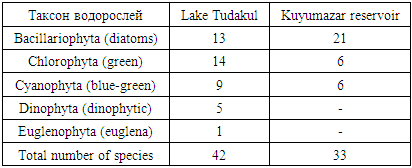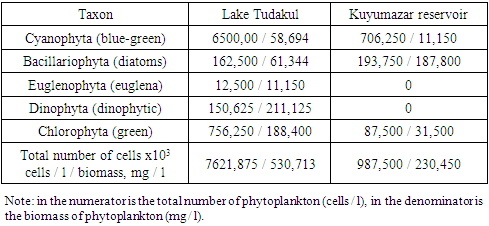-
Paper Information
- Next Paper
- Previous Paper
- Paper Submission
-
Journal Information
- About This Journal
- Editorial Board
- Current Issue
- Archive
- Author Guidelines
- Contact Us
American Journal of Medicine and Medical Sciences
p-ISSN: 2165-901X e-ISSN: 2165-9036
2021; 11(2): 84-87
doi:10.5923/j.ajmms.20211102.02
Received: Jan. 7, 2021; Accepted: Jan. 23, 2021; Published: Jan. 25, 2021

Research and Evaluation of Qualitative and Quantitative Composition of Phytoplankton in Surface Reservoir
N. A. Nuraliev1, Sh. B. Jumayeva1, H. H. Tuxtayeva1, Z. Naimova2, F. M. Baqoyeva3
1Bukhara State Medical Institute, Bukhara, Uzbekistan
2Senior Lecturer, Department of General Hygiene and Ecology, Samarkand State Medical Institute, Samarkand, Uzbekistan
3Assistant of the Department of Clinical Anatomy, Tashkent State Pediatric Institute, Uzbekistan
Copyright © 2021 The Author(s). Published by Scientific & Academic Publishing.
This work is licensed under the Creative Commons Attribution International License (CC BY).
http://creativecommons.org/licenses/by/4.0/

The aim was to study and assess the qualitative and quantitative composition of phytoplankton in surface water bodies of the Bukhara region. It was found that Bacillariophyta (34 species), Chlorophyta (20 species), Cyanophyta (15 species), rarely Dinophyta (5 species), Englenophyta (1 species) were found more often in Lake Tudakul and the Kuyumazar reservoir. The highest total phytoplankton abundance in the water of both reservoirs was Cyanophyta, and the highest phytoplankton biomass was recorded in Bacillariophyta and Chlorophyta. At the same time, Englenophyta and Dinophyta were not found in the waters of the Kuyumazar reservoir. In the phytoplankton samples from Lake Tudakul, planktonic freshwater-brackish-water forms b-mesosaprobic predominated; brackish-water b- and b- and α-mesosaprobic species of algae prevailed.
Keywords: Hydrobiology, Phytoplankton, Surface water bodies, Total abundance and biomass of phytoplankton
Cite this paper: N. A. Nuraliev, Sh. B. Jumayeva, H. H. Tuxtayeva, Z. Naimova, F. M. Baqoyeva, Research and Evaluation of Qualitative and Quantitative Composition of Phytoplankton in Surface Reservoir, American Journal of Medicine and Medical Sciences, Vol. 11 No. 2, 2021, pp. 84-87. doi: 10.5923/j.ajmms.20211102.02.
Article Outline
1. Introduction
- In conditions of low water under the influence of intensive anthropogenic impact in Uzbekistan, the rational use of water resources in the national economy is important. In this regard, continuous monitoring, assessment of the variability of the microbial, chemical composition, hydro biological parameters of water in reservoirs is of great importance [6].Changes in the chemical and mineral composition of water affect the microbial composition of water in surface (open) water bodies. Pathogenic microorganisms transmitted by water, adapting to these conditions, change their biological properties [7].Due to the vital activity of aquatic organisms, the chemical composition of water is formed, thereby determining its quality. The permanent microflora of water bodies performs the function of a primary oxidant or reductant of pollutants entering the water body [4].An important part of aquatic ecosystems is aquatic biota, represented by a mosaic of interconnected biocenoses that occupy all possible biotopes in streams and reservoirs: they inhabit the water column (plankton), the thickness and surface of the soil (benthos), overgrow the surface of solid rocky substrates washed by water or settling on the surface of macrophytes and in the turf of water moss (periphyton). Their species composition and structure are entirely determined by climatic and landscape conditions prevailing in drainage basins or directly in river corridors and coastal zones of lakes [1,2,3].Consequently, biocenoses can be considered as information systems that characterize the condition of not only specific water bodies, but also the surrounding natural complexes on the territory of which they are located [8].Phytoplankton are microscopic plant organisms that freely hover in the water column and carry out photosynthesis, and are one of the important elements of aquatic ecosystems involved in the formation of water quality and the productivity of a reservoir [9,10,11].As is known, the study of phytoplankton occupies an important place in biomonitoring, since algae assimilate solar energy, accumulating it in the form of organic compounds in the process of photosynthesis, while releasing oxygen necessary for the respiration of algae themselves and other inhabitants of the reservoir [5]. The organic matter synthesized by them serves as a source of energy for heterotrophic organisms - bacteria, animals. Therefore, the properties of the phytoplankton link of an ecosystem determine its condition.The abundance, biomass, taxonomic composition, and physiological activity of phytoplankton make it possible to draw conclusions about the well-being of the water body or its critical condition [8].The purpose of this research work was to study and evaluate the qualitative and quantitative composition of phytoplankton in the studied areas of surface reservoirs of the Bukhara region.
2. Materials and Research Methods
- The composition, abundance, and distribution of phytoplankton over surface (open) water bodies of the region studied by us (Bukhara region of the Republic of Uzbekistan) are due to different hydrological, hydrochemical conditions and anthropogenic impact.We have investigated the surface water bodies of the Bukhara region - Lake Tudakul and the Kuyumazar reservoir, which are used for household, drinking, cultural and irrigation purposes. The researches were carried out in the spring and summer of 2020. There were examined 16 samples taken from different places of these reservoirs.In biological research, the most reliable and acceptable method for sampling phytoplankton from surface water is the bathometric method. Samples taken with a bathometer were used both for quantitative accounting and for the qualitative characterization of the sample taken.In the researches carried out, phytoplankton samples were taken with a one-liter Ruttner bathometer: samples were poured 250 ml into 500 ml dishes, mixed (i.e., integral samples were taken).For high-quality collection of phytoplankton, we used silk gas plankton net No. 76. For “soft” fixation of phytoplankton samples, Lugol's solution (until slightly yellow) was used, followed by the addition of 40% formalin (10 ml of 40% formalin is sufficient for 0.5 l of the sample).It should be taken into account that high concentrations of the specified fixative cause deformation of algae and a change in the color of their pigment [8].Phytoplankton samples were collected according to generally accepted algological methods [5,8]; identification guides were used to identify the species composition of microalgae [10,11].The sample taken in a polyethylene bottle was fixed with 40% formalin and Lugol's solution, supplied with a label (sample number, date, water body, by whom it was taken, in the presence of whom the sample was taken). Standard horizons for water sampling were: 0 (surface); 0.5; 1.0; 2.5; 5 m.The sediment method was used for phytoplankton samples under conditions. Then, according to the methods, the precipitate was brought to 100 ml.In office conditions, the sedimentation method (sedimentation) was used to concentrate samples, because Planktonic cells settle at a speed of 1 cm in 3 hours [9], then the samples were settled in a dark place for 5-10 days, and then the filtrate was slowly sucked off with a siphon through a double layer of plankton net from silk gas No. 76 (this helps to preserve the fine structures of algae).The compaction of the taken sample was carried out in 2 stages: from 0.5 L (500 ml) to 0.1 L (100 ml). Then, after secondary settling (no more than 5 days), the solution was sucked off again. Poor samples (winter-spring) were brought up to a volume of 10 ml (usually up to 20 ml), very rich (summer ones during the “blooming” blue-green period) - up to 50 ml, sometimes even up to 100 ml, in this case the secondary settling of the sample is not produced).The quantitative processing of the material was carried out according to the generally accepted algological method in a Goryaev chamber with a volume of (0.001 mm3) or in a Fuchs-Rosenthal chamber with a volume of (3.2 mm3). Further research was carried out in the laboratory using a MEIJI light microscope.The data obtained by counting phytoplankton were used to calculate their abundance, for which the conversion formula was used:N = n x v1 / v2 x W, where,N is the number of cells in 1 cm3 of water;n is the number of cells in a 1 mm3 chamber;v1 - Volume of sample concentrate (cm3);v2 - Chamber volume (cm3);W - The volume of the taken sample (cm3).The biomass of the studied phytoplankton was determined by a generally accepted calculation method [3,8].In the course of research, the following qualitative and quantitative characteristics of phytoplankton were determined: species composition of phytoplankton; the number of species in each main group; taxonomic composition of phytoplankton; number and biomass of species and main groups of phytoplankton - number of cells x103.
3. Research Results and Discussion
- During the reconnaissance trip, samples of phytoplankton were taken, in which 75 species, varieties and forms of algae were found: diatoms (Bacillariophyta) - 34 species; green (Chlorophyta) - 20 species; blue-green (Cyanophyta) - 15 species; dinophyta (Dinophyta) - 5 species; Euglenophyta (Euglenophyta) - 1 species.The taxonomic structure of phytoplankton in water bodies of the Bukhara region is presented in table. 1.
|
|
4. Conclusions
- 1. In the studied water bodies (Tudakul lakes and Kuyumazar reservoir) of the Bukhara region, the following types of algae are more often found: Bacillariophyta (34 species); Chlorophyta (20 species); Cyanophyta (15 species); less often - Dinophyta (5 species); Englenophyta (1 species).2. It was revealed that the highest total phytoplankton abundance in water samples from both reservoirs was Cyanophyta (6500.00x103 cells / l and 706.250x103 cells / l, respectively), and the highest phytoplankton biomass was noted in Bacillariophyta (187.800 mg / l) and Chlorophyta (188.400 mg / l). At the same time, Englenophyta and Dinophyta were not found in water samples from the Kuyumazar reservoir.3. It was proved that in the phytoplankton samples from Lake Tudakul, planktonic freshwater-brackish-water forms b-mesosaprobic predominated; brackish-water b- and b- and α-mesosaprobic species of algae prevailed.
 Abstract
Abstract Reference
Reference Full-Text PDF
Full-Text PDF Full-text HTML
Full-text HTML
